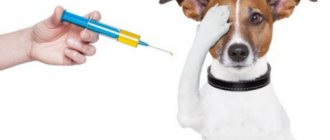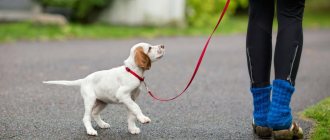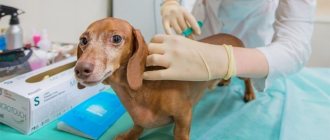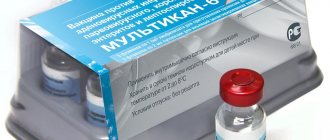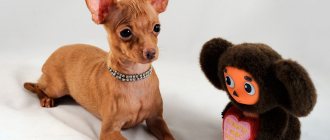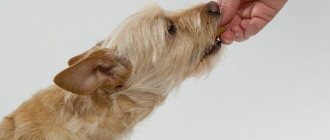Until a certain age, puppies go to the toilet indoors and are not taken out for walks. The owners teach their pet to use the litter box, but the baby may get lost in playing and not even notice that he has made a puddle right on the floor. It is only logical that the happy owner of an adorable dog is looking forward to the day when his pet goes outside for the first time. In this regard, questions arise: is it possible to walk a dog after the first preventive vaccination or do you need to endure quarantine?
How to prepare your dog for vaccination
Animals are vaccinated from birth. The first vaccinations are administered to puppies at the age of 8 - 10 weeks; for their safety, a veterinarian is called to the house, who draws up a schedule for the administration of each vaccine and conducts a preliminary examination.
Dogs are recommended to be vaccinated against rabies, distemper, and parvovirus enteritis - fatal infections that require immediate action in case of infection. Animals are also vaccinated against:
- Leptospirosis is a bacterial disease. It is characterized by anemia, fever, hemorrhagic lesions of the liver, kidneys, intestines, disorders of the nervous system;
- coronavirus enteritis - a viral disease that affects the gastrointestinal tract, it depletes the dog, leads to dehydration, the mild and medium stages are treatable;
- viral hepatitis – liver infection;
- parainfluenza - a respiratory disease is vaccinated during periods of focal tension.
Living in areas endemic for ticks requires additional vaccinations against piroplasmosis and borreliosis. In some cases, the animal should be vaccinated against lichen.
Read. Vaccinations for kittens: first vaccination, how to do it correctly, cost
Responsibility for ensuring timely vaccinations lies with the dog owner. He also monitors the storage conditions of the drugs, deworms the animal 14 days before vaccination, and gets rid of fleas. The measure is aimed at maintaining the dog’s immunity, which is weakened when infected with parasites. Vaccinations are only given to healthy pets that have been examined by a veterinarian.
Etiology of diseases
All three infections are viral in nature and affect the respiratory system and immune system. In severe cases and complications, internal organs, vision, the reproductive system (with mumps) and the nervous system can be damaged.
- Measles is characterized by a combination of eye and respiratory tract lesions and skin rashes. First manifestations:
- small white spots on the cheeks and gums (Koplik's sign);
- redness of the eyes;
- snot, nasal congestion;
- dry strong cough;
- heat;
- a pinpoint red rash that appears from the top of the head to the heels. Source: I.L. Solovyova, E.A. Alexandrova, E.M. Lezhen, O.V. Anosova, A.A. Solovyeva Vaccinal prevention of measles and mumps in children in modern conditions // Ulyanovsk Journal of Medical Biology, 2013, No. 4, pp. 47-53
Without treatment, measles is dangerous for the development of purulent otitis, bronchitis and pneumonia, as well as the formation of encephalitis.
- Mumps is a lesion of glandular tissue and respiratory organs. Typical for him are:
- runny nose;
- temperature increase;
- severe malaise with headache;
- muscle aches;
- pain in the masticatory muscles when swallowing;
- inflammation of the salivary glands with swelling behind the ears and along the edge of the lower jaw;
- dry mouth, decreased appetite, severe thirst.
With complications of mumps, inflammation of the appendages (in girls) and testicles (in boys) may develop, followed by infertility, as well as deafness, and the development of meningitis.
- Rubella is milder and is characterized :
- moderate temperature;
- redness of the eyes;
- the appearance of a rash on the skin;
- enlarged lymph nodes in the back of the head and neck;
- joint damage.
Rubella is especially dangerous for children and can lead to bronchitis and otitis media. For pregnant women, there is a risk of fetal defects. In rare cases, children may have bronchitis, otitis media or pneumonia.
Should you keep your dog in quarantine after vaccination?
Limitations for contact with other animals are the age of the dog. The first and second vaccinations of puppies are aimed at developing stable immunity to the introduced viruses. The owner should understand that antibodies are developed gradually over 10–14 days, and after rabies vaccination – 3 weeks. During this period, it is worth taking the puppy outside in your arms for a short time.
Adults have a developed immune system, so restrictions on walking are conditional. It is better to walk separately from other animals; the dog should not be let off the leash.
Exceptions to the rules or advice is not a ban
There have been known cases where the quarantine regime in dogs passed within a couple of days after the vaccine was administered to the body. Owners told how their dogs were given vaccines, but they quickly returned to normal and jumped into the water to swim. This is an example of dogs with strong immunity that can resist viruses and infections, but this does not mean that any other dog in fairly comfortable conditions will recover as quickly.
In quarantine mode, the dog’s body is sick, but in a mild form, and when he suffers from the disease, it is very easy to weaken it. Therefore, if your dog is dirty and you see no other way out but to bathe it, then make sure that you can provide it with all the necessary conditions to comply with the quarantine regime. If you bathe your dog, you need to do it in a well-heated room and, after taking water treatments, keep it there until the fur is completely dry.
Any sudden changes in temperature will then negatively affect the health of the animal even more. In this case, the owner must be prepared for the fact that the dog may get worse.
Features of walking puppies after vaccination
Babies stay with their mother for up to 1.5 months, remaining protected by antibodies obtained from mother's milk. The first vaccination is given from 2 months of age, after 21 days, the vaccine is administered again. Rabies vaccination is carried out later, 3 weeks after the last vaccination with another drug. By the way, rabies is especially dangerous for animals, so all pets up to 6 months of age are vaccinated against it.
Primary vaccination is the starting point in the formation of a stable immune barrier for the dog; if for some reason immunization was not carried out, it should be scheduled for the time of change of baby teeth (about six months) and protect the puppy from active contacts with the street.
Due to the fact that vaccinations are prescribed to healthy puppies, it is not recommended to go for walks before vaccination. The quarantine is extended for the period of the first three injections, and from the moment of the rabies injection, 21 days are counted, necessary for the development of a sufficient number of antibodies. During quarantine, walking with your baby is prohibited to protect his health.
In rare cases, a short walk in your arms is allowed, without allowing the dog to come into contact with the ground or with unfamiliar animals. At home, the pet is protected from interactions with shoes, street clothes, and entrance mats, which may contain rabies viruses and microbes.
Read. Distemper vaccinations for cats
Quarantine after vaccination is established for two weeks, including after annual revaccination. Similar measures are taken for injections to prevent rabies. In addition to the ban on walking, it is worth taking care of the well-being of your pet. His mobility decreases, he refuses to eat, drowsiness, and possibly vomiting and diarrhea. Local reactions at the vaccine site (burning, itching) are common. During the post-vaccination period, the dog may show symptoms of the disease for which it was vaccinated.
Features of caring for domestic and apartment dogs
It's another matter when your dog lives with you in an apartment or in a private house. Although, when it comes to vaccinations, then such dogs also need to be provided with proper medical care. After all, from time to time a domestic dog visits the open air and you can never be completely sure who he will meet there and which animal will be especially interesting to him.
Usually, the owners of such dogs prefer to bathe them regularly, because few people would want a dirty dog living in their house, which, moreover, smells unpleasant. Dust, dirt and many other small particles get on the dog's paws and fur, which after some time may end up in the house. In addition, water treatments will help maintain dog hygiene. But if your dog has recently been vaccinated, then there are some nuances regarding various types of water procedures.
When to walk your adult dog after vaccination?
Immunization for stronger adult animals is repeated annually, and the injection is given with complex preparations, including pathogens of several infections. It is permissible to add a separate injection to the indicated injection, which forms resistance to rabies. In females, the immunization schedule depends on estrus, mating, and begins a month before the indicated processes.
Walking adult dogs is not prohibited, but by the end of the 11th – 12th month, immunity decreases, so you should walk before and after vaccination for 14 days separately from other dogs, without intense physical activity. It is better to extend the quarantine period to 21 days to avoid contracting rabies. In cold weather, the dog does not need to be washed; just rinse its paws with warm water and treat the coat with dry shampoo.
Read. Vaccinations for the Yorkshire Terrier: puppy preparation, vaccination table
After quarantine, the dog is gradually returned to active activities, allowed to swim in reservoirs, and restrictions on interactions with any animals are removed.
Rules for bathing a pet
The puppy can be washed in the bathroom or under the kitchen faucet. To minimize discomfort, you should bathe your Yorkie in compliance with the following rules:
- Before bathing, the puppy's skin is examined for damage. If there are injuries, washing is postponed until complete healing.
- Premium cosmetics are highly concentrated. Before use, it must be diluted with water according to the instructions.
- Bath procedures should not cause fear. In the process, they avoid sudden movements that can frighten the Yorkie puppy, talk to him affectionately and praise him.
- To prevent water from getting into the ears, they are covered in advance with cotton swabs or sprinkled with special powder.
- You need to bathe your Yorkshire Terrier as quickly as possible to prevent it from freezing. For professional breeders and groomers, this takes 7-10 minutes.
Choosing dog washing products
Both puppies and adult Yorkies are bathed only with special cosmetics. Care products are not suitable for people - they have a more aggressive composition, so they dry the skin and cause allergies.
Important. The Yorkshire Terrier should not be bathed with cheap cosmetics - it will do more harm than good.
Water ranks first in dog shampoo, followed by sodium laureth sulfate or other surfactants. They perfectly cleanse the skin and coat, but can cause irritation. Therefore, high-quality products contain additives that mitigate the negative effects.
They also contain moisturizing and nourishing components that improve the structure of the fur.
Dog trainers and breeders recommend bathing Yorkies with the following brands of shampoo:
- Royal Groom – designed specifically for Yorkshire Terriers. Restores dry ends, smoothes hair, enhances shine.
- IvSanBernard is a hypoallergenic shampoo, suitable even for Yorkies with sensitive skin. Carefully cares for the coat, restores the protective layer, and is suitable for frequent use.
- Artero Hidratante – contains horse chestnut and chamomile extracts, provitamin B. Moisturizes and restores damaged hair.
- ReQual Nutri Derm - contains propolis, willow leaf extract and yeast extract, which perfectly moisturize, add shine and softness.
- Pet Silk – fights dandruff and inflammation, increases fur elasticity and color saturation.
- ReQualVitalProf - nourishes, conditions, makes fur shiny and silky.
- AllSystems - the line includes nourishing, regenerating, moisturizing, softening and strengthening detergents. The products consist of plant materials without the addition of chemical components.
- Artero – enriched with moisturizing agents and vitamins, adds volume and shine.
Important. Yorkies can be bathed with shampoos that have a neutral pH level. Manufacturers indicate this information on the packaging.
There are medications for dandruff, fungus, and bacterial infections, which are used in courses as prescribed by a doctor. They cannot be used to bathe a Yorkshire Terrier on a regular basis.
Conditioner for dogs is necessary to improve the decorative qualities of the coat. After using it, the Yorkie's coat is easy to comb, does not get tangled, and does not become electrified. The effect is achieved by restoring the protective layer of hairs, which is washed off with shampoo.
It is better to choose conditioner of the same brand as the shampoo. Their components combine well and enhance each other's effects. The fur of show Yorkshire terriers is additionally lubricated with oil:
- jojoba;
- palm;
- grape seeds;
- peach;
- coconut;
- wheat germ.
The oil makes hair elastic, prevents split ends and brittle ends.
Important. Before using cosmetics for the first time, it is recommended to conduct a test - soap a small area on the inner thigh. If the reaction is normal, the entire Yorkie puppy is bathed with the product.
Basic rules of vaccination
Before going to the veterinary clinic, you need to know the vaccination rules in advance:
- Vaccinations for Yorkie dogs should not be given to puppies at too early an age. From the moment they are born, tiny Yorkies are protected by feeding on their mother's milk. As they begin to be weaned off milk, puppies begin to develop their immunity.
- If the puppy is sick or has just recently been ill, then it is not recommended to vaccinate him. This is due to the fact that the puppy’s body is weakened, and it may not tolerate vaccination well. It would be optimal to wait 2-3 weeks after recovery and get vaccinated.
- Vaccination and revaccination must be carried out with the same vaccine. This should not be forgotten when choosing a vaccine. It is also recommended to familiarize yourself in advance with the composition of the selected vaccine, contraindications and possible side effects, and check the expiration date.
- After vaccination, it is recommended to spend the first 2-3 hours with the puppy and observe its condition. Small breed puppies may experience an allergy attack, and it will be important to get him help in a timely manner.
- It is recommended to purchase the vaccine only from veterinary pharmacies and clinics. A vaccine purchased in a regular store can be dangerous, since there is a high probability that it will be counterfeit, or expired, or spoiled by improper storage.
- If the owner of the puppy plans to attend exhibitions, cynological competitions or travel abroad with him in the future, then it is recommended that vaccinations be given only in veterinary clinics. After the procedure, the veterinarian will put a vaccination note and a clinic stamp in the Yorkie’s veterinary passport. And vaccinations administered independently at exhibitions, competitions and when crossing the border do not count.
Possible side effects
Almost all puppies tolerate vaccinations well.
During the first 2–3 days, a decrease in appetite and increased drowsiness are sometimes possible.
In extremely rare cases, due to individual intolerance to the components of the vaccine, an allergic reaction may develop, manifested by itching, vomiting, diarrhea, swelling of the face, and difficulty breathing. These conditions require immediate medical attention.
